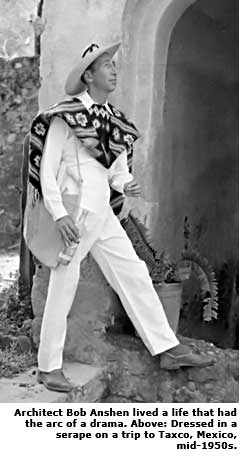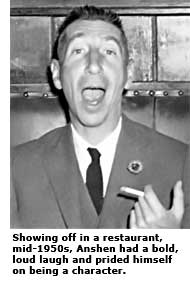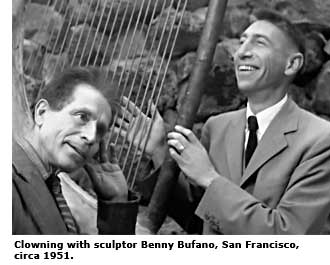Eichler Architect, Bob Anshen: Self-Made Man
By all accounts Robert Anshen should have been in pictures—though he did not have matinee idol looks.

"Anshen was aggressive, loud, sarcastic," says Ned Eichler, son of the builder Joe Eichler, who was Anshen's second most important client back in the 1950s. "Also, he was absolutely ugly. He was like a character out of Dickens. He had a small body, and the size of his head bore no relation to the size of his body."
Still, when Anshen was onstage—and he was always onstage—he absolutely commanded attention—so much so people barely noticed his lifelong architectural partner and best friend, Steve Allen, even though Allen was a large man and Anshen short and thin, weighing in at roughly 125 pounds. "Steve was always so quiet," says Augie Rath, who worked for their San Francisco-based firm, Anshen and Allen, in the 1950s and '60s. "Bob, you knew the instant he walked in the door."
"When Anshen laughed, it was really a bold, loud laugh. He prided himself on being aggressive, on being a character. I think to some degree he invented himself," Ned Eichler says, adding, "Anshen was one of the greatest characters I've ever met."
Anshen's life itself had the arc of a drama, a picaresque tale that veered from hero quest to mystery story, leavened throughout with comedy.
The drama recounts how Anshen (born 1910) and Allen (1912), both Easterners, stranded in San Francisco in 1937 by poverty after traveling the globe, convinced a multi-millionaire to give them their first job—a job that put them on the map and that led to most of the jobs that followed; how Anshen, a hero with an outsized personality and seemingly magical powers, made a name for himself as a young David battling the Goliath of the International Style; how he championed housing for the masses, prefabricated dwellings, and regional planning; how he worked with Joe Eichler to give America its largest collection of modern tract homes; how he became a Brooks Brothers bohemian; and how, a flawed hero, he died suddenly and young, his death surrounded by mystery.

Anshen and Allen, best known today as the original designers of Eichler homes, were responsible for several defining innovations, including the homes' orientations to the backyard, and the atrium. The firm worked on Eichler homes from 1950 to 1960, when Claude Oakland, an employee who had been doing much of the design, formed his own firm and took over the account.
In a 1960 article in the American Institute of Architects Journal, Anshen discussed the genesis of their design for Eichler Homes. He and Allen decided in 1949 "as a matter of policy that wherever possible the building would be blank to the front," he wrote. Anshen and Allen's concern was with privacy.
Eichler, Anshen wrote, was "leery" about the suggestion, worrying "whether a house that did not look like a house but looked like a blank wall to the street would sell at all, but being a forward-thinking man, he went along with the architect."
But Anshen and Allen did much more than Eichler homes. Theirs was one of only a handful of Bay Area modern firms that got its start before World War II. The firm played a major role in setting the tone for Bay Area modernism as something warmer and more Wrightian than its Southern California counterpart.
And although Anshen and Allen collaborated closely—"No one of them did anything without the full discussion and approval of the other," says Derek Parker, a longtime architect with the firm—it was Anshen who, through his personality, defined the firm. It was certainly Anshen, a wily marketer who secured many of the jobs.
"Bob had a way of talk that was extremely convincing," says Donald Olsen, a good friend in the 1940s and early '50s. "He didn't allow the other person to object."

"He was an actor," says Los Angeles architect Ray Kappe, who worked for Anshen and Allen in the early 1950s. "He demanded attention."
His face might not have been pretty, but it was expressive—especially when telling jokes, the late architect Warren Callister remembered. "Bob Anshen's face was like something rubber."
Like an actor, Anshen had a magic that drew people to him. And despite his looks, women swooned.
"It was common for him at a party to come behind a woman and pinch her on the fanny," recalls architect Donald Olsen, "and she would turn around in wrath, and he would look at her and she would just fall. She was his!"




